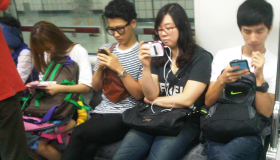Trend Watching: 10 major trends of 2013
 As usual, at the end of the year, the mass of publications publishes collections of various trends, someone writes his ideas and conjectures, someone predicts ala Nostradamus. And there are companies that make money on it, whose predictions they buy and they come true.
As usual, at the end of the year, the mass of publications publishes collections of various trends, someone writes his ideas and conjectures, someone predicts ala Nostradamus. And there are companies that make money on it, whose predictions they buy and they come true.For example, Trend watching , a company that searches and analyzes patterns. Their clients are both very large businesses and small teams. At first glance, the results of analytics may seem strange and unusual, but following the theory of the long tail , it may well become ideas for creating a new service or product. After all, these trends are in fact a synonym for a ready-made audience request.
To your attention the 10 most important custom trends from Trend Watching for the next 12 months:
1. Expectants and Cost Controllers
 Since users will be even more involved in creating, launching and developing new products, services and favorite brands, expect that pre-orders, crowdfunding and the process of attracting customers will turn the traditional “consumption” system in 2013.
Since users will be even more involved in creating, launching and developing new products, services and favorite brands, expect that pre-orders, crowdfunding and the process of attracting customers will turn the traditional “consumption” system in 2013.In the coming year, you will see enthusiastic users who will open for you two completely new, innovative consumption patterns: “expectations” and “cost controllers”
')
"Expectors" like to be involved in the process of the emergence and promotion of products and services before their official release. And, thanks to the countless crowdfunding platforms and new production technologies that are gradually becoming everyday practice (as well as the “cult of entrepreneurship”), business will open new doors for you, which, in theory, these neo-users should “break”.
In this regard, you should not be surprised by the fact that this year the “expectants” spent $ 2.8 billion on crowdfunding platforms (for comparison: $ 530 million in 2009, $ 1.3 billion in 2011).
And who besides the "waiting"? How about “cost controllers” - users who move from standard consumption to investing in their favorite brands (even without having in their portfolio the shares of these companies).
However, both of these types of neo-consumers expect that they will get both financial and emotional returns, and therefore, only those brands that are open, friendly, honest, trustworthy and “transparent” will attract them.
Examples:
ZAOZAO : social service for fashion lovers.
Launched in September 2012 in Hong Kong, the service refers to itself as a “social preorder”. This new platform allows fashion designers to place their “preliminary” creations in order to get pre-orders with the help of crowdfunding, thereby sponsoring further work.
Brikstarter : assistance in developing prototypes for Kickstarter.
Service launched in November 2012, as the British counterpart Kickstarter. The company offers users to find funding for their projects (CAD design, 3D-print models, the creation of promotional video). Product creators give the service 10% of funds raised, as well as 10% of revenue.
Leon Bonds : food voucher service.
In July 2012, a Leon healthy food franchise from the UK created a Leon Bonds project and raised £ 1.5 million from users to scale.
Barclaycard Ring : Social Credit Cards.
If you do not want to sell the shares of your company, but want to reward your consumers, then the case of Barclaycard Ring MasterCard, a “social” credit card developed on the basis of “virtual” crowdsourcing, will be useful for you. With the help of the Internet, users can make suggestions and make decisions about how the service is developing and what programs it implements. Users also receive income from service profits.
2. Third World
 While over the past two decades, third world countries have been supplying the markets of developed countries, and the Big Five countries have been promoting their products in emerging markets only, there has been a tendency for total promotion of products and services of developing countries in their own, emerging markets.
While over the past two decades, third world countries have been supplying the markets of developed countries, and the Big Five countries have been promoting their products in emerging markets only, there has been a tendency for total promotion of products and services of developing countries in their own, emerging markets."New brands from all over the world for the nascent world middle class!"
For example, Chinese and Brazilian middle class brands will become popular in Turkey, India and South Africa. And vice versa.
As a result, taking into account the intensity of the work of such brands in emerging markets and for a progressive middle class, we will get a rapid increase in the influence of third world markets on the global economy.
The figures speak for themselves: in 2013, the GDP of developing countries for the first time will exceed the level of the highest echelon countries - $ 44.1 trillion against $ 42.7 trillion.
The question every company with big ambitions should ask itself (regardless of its membership in a developing market): who is the most powerful NEW player in your industry?
Looking for examples? Look for them below. They will help you correctly assess your main potential competitors of the coming year.
WeChat : Chinese messenger with 200 million users worldwide.
Voice, text and photo instant messaging services changed their local name “Weixin” to a new one in order to allow themselves to scale and enter global markets. In September 2012, the service added support for Hindi in India, as well as support for the Portuguese (for the Brazilian market) and Indonesian. Today it has 200 million users worldwide.
Peak Games : the world's third largest gaming platform.
The Turkish project Peak Games today has 30 million active users every month, inhabiting Turkey, the Middle East and North Africa. The company increased its revenue 10 times in Q1 2012 compared to 2011.
Amazonas Sandals : Brazilian slippers and sandals in China.
In October 2012, the Brazilian shoe brand Amazonas Sandals announced its plans for opening a store in Guangzhou (China) in early 2013. Amazonas Sandals are made from Brazilian raw materials (80% is recyclable).
Lenovo : Asian smartphones.
In October 2012, Lenovo launched sales of a range of smartphones of varying degrees of availability in Indonesia. Manufacturers announced the launch of sales in the Indian market in March 2013. These steps are aimed at strengthening and improving their positions in the Asian market (at the moment, Lenovo is the second largest sales of smartphones).
BluePad : Colombian tablets available in Latin America.
Copumax launched the first Colombian tablet developed in Bogota. BluePad has a 7'-inch screen, Android 4.0 OS, 4GB of internal memory, expandable up to 32 GB using Micro SD card. The tablet costs only $ 214 — the most affordable tablet on the market — and you can also order it in Venezuela and Ecuador.
3. Mobile stuff
 For those who are thinking about the fate and future of the mobile world, we offer you to familiarize yourself with one important insight: in 2013, people will use their smartphones wherever possible in order to get the maximum benefit from communication and networking. Such a “mobilization” will affect ABSOLUTELY all aspects of human life.
For those who are thinking about the fate and future of the mobile world, we offer you to familiarize yourself with one important insight: in 2013, people will use their smartphones wherever possible in order to get the maximum benefit from communication and networking. Such a “mobilization” will affect ABSOLUTELY all aspects of human life.“Life at maximum speed for solving a multitude of problems - the digital-sphere will become the leader in 2013.”
The exhausting urban rhythm of life means the almost complete absence of at least some time for irrelevant content: the user needs only interesting information, useful connections and quality entertainment.
All this means that in the next 12 months we will see an even greater explosion of the mobile world: products and services that allow us to experience a lot in a rapidly changing, mobile world.
We could offer you a lot of statistics related to mobile applications, but we understand that you simply do not have time to study it, so we give you the opportunity to learn and understand the 3 most important aspects:
- 63% of women and 73% of men use their smartphones much more often than once per hour.
- Owners of mobile gadgets aged from 18 to 25 on average send 109 messages per day, more than 3200 per month.
- A study of the habits of Android users has shown that the duration of using one application is less than a minute per hour.
Still thinking how to succeed with your business in the mobile world? Study the trends of the year and try to apply them correctly, given the acceleration of the rhythm of life.
We invite you to familiarize yourself with the examples below in order to get ideas for reducing the wasted seconds and creating a quick and convenient service.
Projekt Ingeborg : virtual library in Klagenfurt, Austria.
In July 2012, the Projekt Ingeborg service was launched, which provides users with access to the virtual library using stickers with QR codes pasted throughout Austria. The need for the service was due to the lack of a public library in Klagenfurt. So the founders of the startup made it possible for all residents to familiarize themselves with the library's literature using yellow stickers, which can be found, for example, at a bus stop.
Jana : a mobile market analysis platform.
Jana allows mobile phone users to participate in market research via SMS. The service rewards participants with free minutes of calls and SMS, thanks to the cooperation with the largest mobile operators. Today, the service has more than 3.5 billion users in more than 100 countries.
Snapchat : photo application for "temporary" photos.
The application allows the user to share pictures that can be viewed by users for only a few seconds before they self-destruct. The creators of the application announced that in October 2012 the number of streaming images exceeded 20 million per day!
WeChat : social messenger
To the above, we add that the application offers a lot of opportunities to communicate with new, strangers. For example, the 'Remote Shake' function connects two random people who shook the phone at the same time, and the 'Drift Bottle' allows the user to send a message - a kind of “message in a bottle” - to the network where it can get to anyone.
Pogoseat : take your place.
Pogoseat is an application that allows the user to improve their places on the podium during sports competitions with the help of a smartphone. The application finds free places with the best view, and the user is given the opportunity to occupy these places for a fee.
Peapod : a virtual store of QR codes.
Considering the whole phenomenon of the spread of QR codes, the American online store Peapod.com announced in October 2012 the launch of more than 100 virtual QR stores at the metro stations of Boston, New York, Washington and Chicago. At the same time, QR code stores continue to spread rapidly! You still do not believe in the power of the mobile world today ?!
PS For some of these ideas, our market is not yet ready, and for some it lacks only courage ...
To be continued…
Source: https://habr.com/ru/post/161651/
All Articles